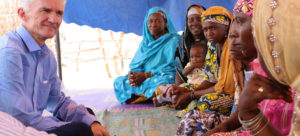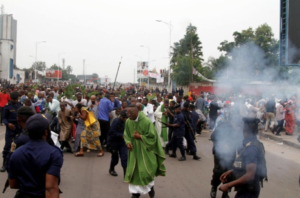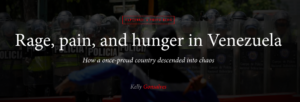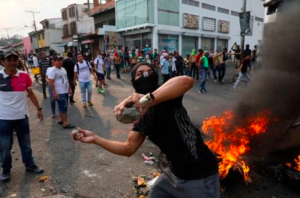Now that we are at the end of the semester, summarize the differences between how the late January ‘you’ and the end-or-semester ‘you’ would define the ‘humanitarian imperative.’ The title of this course is ‘Being and Becoming a Global Citizen’. Summarize the differences between how the late January ‘you’ and the end-or-semester ‘you’ would define ‘global citizen.’
I think the best way to describe January T’keya is as a bit more naive version of me today. I wasn’t ignorant to the fact that people in all facets of all industries abuse power and resources, that some people do humanitarian work for a millisecond because it is a great application enhancer, or even that workers can develop emotional and psychological trauma from their experiences. I’m a bit of a pessimist anyway. Even still, I think the aid sector can be a bit more nefarious than I would’ve even speculated initially. We discussed ways in which corruption seeps into the sector at the large corporation and even governmental level, but I was more surprised by things like child-sex workers and the economic benefit of a prolonged humanitarian crisis. The thought of aid with intention bothers and saddens me because I want to think of aid work as selfless acts where those “white-saviors” and “saviors” in general are not only holding disheveled brown and black children, but they are actually there because those children and their families need help and they are doing the most to do so. Not at all to say many many humanitarians do this, which was encouraging as some form of still kindness exists in the world. I guess, it just hurt to find out that humanitarian aid work is a business, just like every other industry.
I may have be disillusioned in thinking only those really, really kind hearted folk out there, are trekking across the world with biker backpacks and good intentions, while living in poverty-afflicted areas and working effortlessly to get solutions implemented, rather than just sustain a problem. I refer back to Romeo Dallaire’s book, Shake Hands With the Devil a lot now, in part, because I was utterly disgusted with the lack of humanitarian response once the crisis began in Rwanda. I wondered where were all those well-intentioned humanitarian workers, but then I realized, most of them chose to stay on the ground while others fled. I think I tend to think of aid work a bit more now as that small infantry of soldiers who stayed and persisted and helped as many people as they could, while others (who may or may not be the majority) have the title without necessarily being true to its intent.
Sorry to say Arcaro, but I’m much more skeptical after concluding this course and I’m giving aid organizations more of the side-eye, but that’s beneficial too because it has made me more wary of putting my resources and money behind agencies who I have not done extensive research on, whose statistics and implementation plans I can see, and whose methods I agree with. I think of my research on MSF and how they do such great work and are able to provide detailed reports of who needs aid, what needs resources and how they plan on achieving set goals. In turn, I am less triggered by emotive imagery, like poverty porn, and more interested in how these agencies are actually helping. Coming into this course, I thought being a global citizen was being more so respectful to outside cultures, reveling in our differences and similarities, and extending a hand to anyone regardless of their affiliations. I still believe this, even though I still can’t give you a Merriam Webster definition on what the humanitarian imperative is (I don’t really think anyone can simplify it that much), but I can appreciate that being a humanitarian includes so much more that I realized. Both negative and positive.
You were each asked to blog and present about a major humanitarian crisis, and as a class we learned a great deal about Yemen, Syria, and Venezuela, for example. Reflecting on what you and your classmates wrote and what we discussed in class, define and discuss the so-called Dunant versus Nightingale debate and how it applies to any of the crises we covered.
The Dunant versus Nightingale debate related back to what we started off this course discussing. We viewed that starfish video where this seemingly good samaritan was trying to save dozens of starfish by throwing them back into the sea. Instead, he ended up killing them in arguably worse ways than if they were to have died on the beach. Throughout this course, this idea has been present on my mind that even with the best of intentions, humanitarian aid is not always helpful. Or better yet, aid can prolong harm and even do more harm than good. Red Cross founder, Henry Dunant, had the idea of volunteers providing aid where the necessity was seen, which is an admirable position that seems almost selfless. That someone would give of themselves when others were in need, that someone wouldn’t judge a person based on the restricting barriers society applies, but recognize them as human being in need, or that someone could give without anticipated reciprocation.
You would think that if we all followed this theoretical perspective, there wouldn’t be was and genocides in the world, but that’s not the case. I read about the refugee crisis in Cox’s Bazar and the almost 1 million people who fled their homes due to an attempted genocide and also we thoroughly discussed the Rwandan genocide where 800,000 people were slaughtered in only a few days. Dunant’s response would of course be to assist if we can and provide care from neutral standards and I would say I still agree, even reflecting on all we’ve discussed this semester and how shameful the humanitarian sector can be at times. But, both J and Genevieve had similar sentiments that the work is not a vacation, it’s not easy or pleasurable most of the time and you will probably experience some form of atrocity that will damage you psychologically, but it’s a necessary work because there are hundreds of thousands of people being assisted, to counteract the negative components and drawbacks.
When we got introduced to the way Florence Nightingale thought about aid work, I have to say, I was mind blown. The idea that our prolonged presence in a suffering area will only prolong the atrocities more was something I almost didn’t want to agree with, but how could I not. I thought about this neutral component that agencies, like MSF, abide by where no matter who you are, you get aid if you need it. That’s a phenomenal sentiment… however, if you save the life of a terrorist who will then proceed to take dozen more lives, did you play a part in it? Yes? No? Maybe? It’s hard to think of a clear answer. On the flip side, who are you to deny anyone anything when your sole purpose is to serve the afflicted and improve their faulty infrastructures? It’s almost like a double-edged sword because if it is at the core of your ethics to be of service to others, is it then morally wrong to sit aside, knowing what will take place? I hated thinking about it because I felt hypocritical, but I guess that’s how humanitarian aid can be sometimes. The “saviors” who are there to help, but end up extending the problem. That’s a hard place to be.
Ultimately, I agree with Nightingale because when humanitarians act as intermediaries, they stall the “end” of whatever battle is being faced. That may be one side killing all others, that may mean assassinations and vile acts, but they won’t likely last too long. I think of the book Shake Hands with the Devil by Romeo Dallaire and how there was literally a mass slaughter over the course of 100 days. A terrible and heartbreaking event that was hard to even read about. I wonder though, if the event would have lasted years if there were aid workers and military who stayed. No matter what though, I lean more towards Dunant’s way of thinking. I think it may be worse to watch idly as the world goes to hell.








